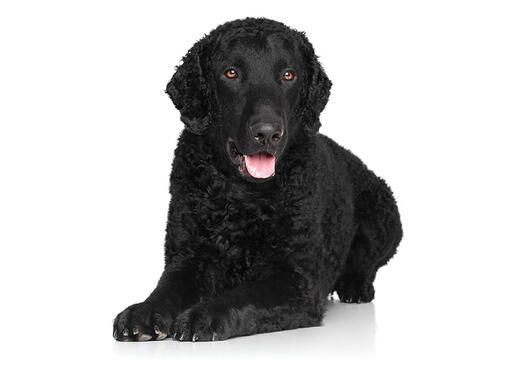
An excellent hunting companion, the Curly-Coated Retriever has a gentle temperament that makes him an ideal family dog. Loving with children and eager to please, this breed is a protective watchdog. The robust, athletic Curly enjoys swimming and needs vigorous daily exercise to keep him from becoming bored and destructive. His short coat requires minimal care and occasional baths.
DID YOU KNOW? The Curly-Coated Retriever descended from the 16th century English Water Spaniel, Retrieving Setter and the Irish Water Spaniel. The Curly became popular in New Zealand and Australia after the breed was imported there from England in 1889. The Curly-Coated Retriever was introduced in the U.S. in 1907.
The need-to-know
- Dog suitable for non-experienced owners
- Some training required
- Enjoys vigorous walks
- Enjoys walking more than two hours a day
- Large dog
- Some drool
- Requires grooming every other day
- Non hypoallergenic breed
- Quiet dog
- Not a guard dog
- May require training to live with other pets
- Great family dog
Personality

A steady, confident, bold dog, the Curly Coated Retriever is quite independent and can seem aloof to those he doesn't know well. With his loved ones, however, he is affectionate and makes a calm, loyal companion. He is very much an 'outdoor' dog and loves exploring his surroundings and retrieving – in and out of the water.
History and Origins

The exact history of the Curly Coated Retriever dog breed is unclear, with many breeds going into its development as a gundog, including various retrievers, the Tweed Water Spaniel and the Irish Water Spaniel among others. The Poodle was also used, to improve the curliness of the coat. The breed was first shown in 1860 and excelled as a shooting dog, but its popularity as a pet and working dog waned with the emergence of the Labrador Retriever.
Nutrition and Feeding

Large breed dogs, as well as having large appetites, benefit from a different balance of nutrients including minerals and vitamins compared to smaller-breed dogs. The Curly Coat, in common with many large breeds, is prone to bloating and stomach problems; smaller, more frequent meals can help minimise this risk.
Exercise

An active dog, the Curly Coat needs two hours of exercise and more a day. He loves retrieving – be it on land or in water – and his waterproof coat serves him well. This is a dog that enjoys 'working', so take a toy for fetch games, to spice up walks
Other Information

Health and common issues
As with many breeds, the Curly Coated Retriever can suffer from various hereditary eye disorders, and hip dysplasia (a condition that can lead to mobility problems). Eye testing and hip scoring of dogs prior to breeding is therefore important.
Best family dog breeds
While many dogs are traditionally thought of as being good with children , all dogs and children need to be taught to get on with and respect each other, and be safe together. Even so, dogs and young children should never be left alone together and adults should supervise all interactions between them.